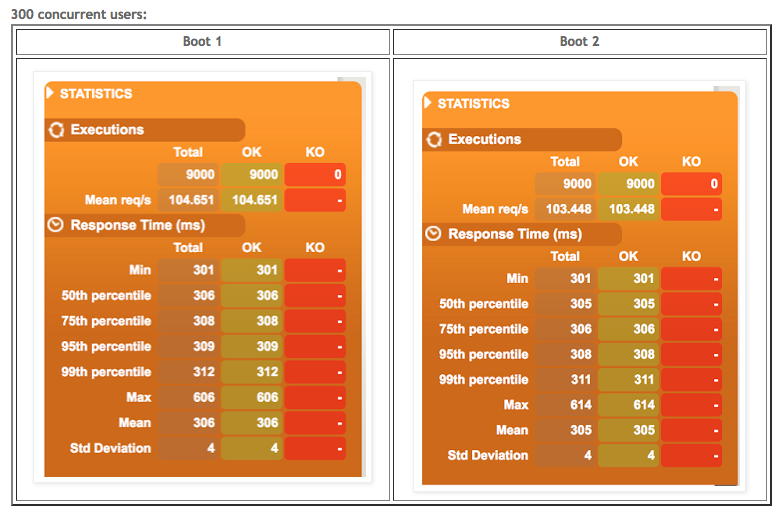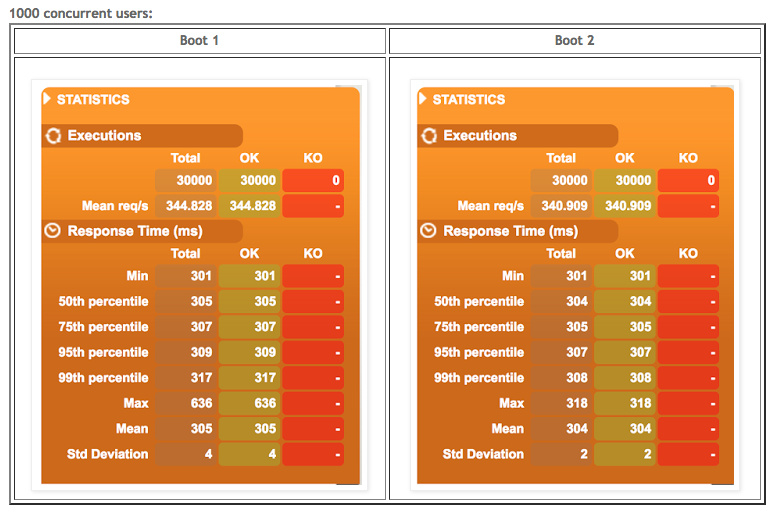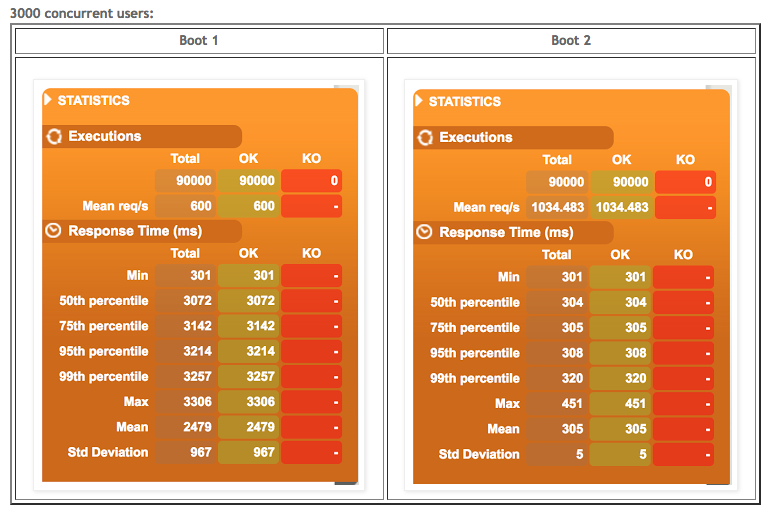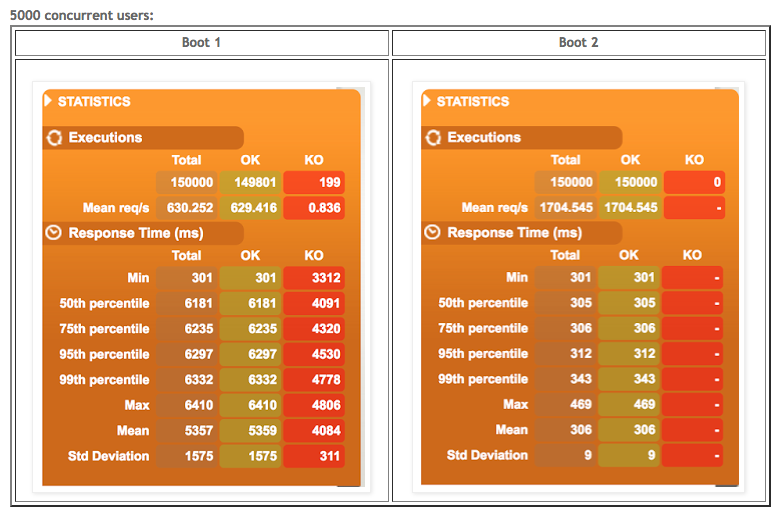Raw Performance Numbers - Spring Boot 2 Webflux vs. Spring Boot 1
Spring Boot 2 significantly outperforms Spring Boot 1. Check out the results of load testing the two iterations and where Spring Boot 2 really shines.
Join the DZone community and get the full member experience.
Join For FreeSpring Boot 2 with a Spring Webflux based application outperforms a Spring Boot 1 based application by a huge margin for IO-heavy workloads. The following is a summarized result of a load test - response time for an IO-heavy transaction with varying concurrent users:
When the number of concurrent users remains low (say, less than 1,000), both Spring Boot 1 and Spring Boot 2 handle the load well and the 95 percentile response time remains milliseconds above an expected value of 300 ms.
At higher concurrency levels, the Async Non-Blocking IO and reactive support in Spring Boot 2 start showing their colors - the 95th percentile time, even with a very heavy load of 5000 users, remains at around 312ms! Spring Boot 1 records a lot of failures and high response times at these concurrency levels.
Details
My setup for the performance test is the following:
The sample applications expose an endpoint (/passthrough/message) which in-turn calls a downstream service. The request message to the endpoint looks something like this:
{
"id": "1",
"payload": "sample payload",
"delay": 3000
}The downstream service would delay based on the "delay" attribute in the message (in milliseconds).
Spring Boot 1 Application
I have used Spring Boot 1.5.8.RELEASE for the Boot 1 version of the application. The endpoint is a simple Spring MVC controller, which in turn uses Spring's RestTemplate to make the downstream call. Everything is synchronous and blocking and I have used the default embedded Tomcat container as the runtime. This is the raw code for the downstream call:
public MessageAck handlePassthrough(Message message) {
ResponseEntity<MessageAck> responseEntity = this.restTemplate.postForEntity(targetHost
+ "/messages", message, MessageAck.class);
return responseEntity.getBody();
}Spring Boot 2 Application
The Spring Boot 2 version of the application exposes a Spring Webflux-based endpoint and uses WebClient, the new non-blocking, reactive alternate to RestTemplate to make the downstream call - I have also used Kotlin for the implementation, which has no bearing on the performance. The runtime server is Netty:
import org.springframework.http.HttpHeaders
import org.springframework.http.MediaType
import org.springframework.web.reactive.function.BodyInserters.fromObject
import org.springframework.web.reactive.function.client.ClientResponse
import org.springframework.web.reactive.function.client.WebClient
import org.springframework.web.reactive.function.client.bodyToMono
import org.springframework.web.reactive.function.server.ServerRequest
import org.springframework.web.reactive.function.server.ServerResponse
import org.springframework.web.reactive.function.server.bodyToMono
import reactor.core.publisher.Mono
class PassThroughHandler(private val webClient: WebClient) {
fun handle(serverRequest: ServerRequest): Mono<ServerResponse> {
val messageMono = serverRequest.bodyToMono<Message>()
return messageMono.flatMap { message ->
passThrough(message)
.flatMap { messageAck ->
ServerResponse.ok().body(fromObject(messageAck))
}
}
}
fun passThrough(message: Message): Mono<MessageAck> {
return webClient.post()
.uri("/messages")
.header(HttpHeaders.CONTENT_TYPE, MediaType.APPLICATION_JSON_VALUE)
.header(HttpHeaders.ACCEPT, MediaType.APPLICATION_JSON_VALUE)
.body(fromObject<Message>(message))
.exchange()
.flatMap { response: ClientResponse ->
response.bodyToMono<MessageAck>()
}
}
}Details of the Performance Test
The test is simple; for different sets of concurrent users (300, 1000, 1500, 3000, 5000), I send a message with the delay attribute set to 300 ms, and each user repeats the scenario 30 times with a delay between 1 to 2 seconds between requests. I am using the excellent Gatling tool to generate this load.
Results
These are the results as captured by Gatling:





Reference
The sample application and the load scripts are available in my GitHub repo.
Published at DZone with permission of Biju Kunjummen, DZone MVB. See the original article here.
Opinions expressed by DZone contributors are their own.



Comments